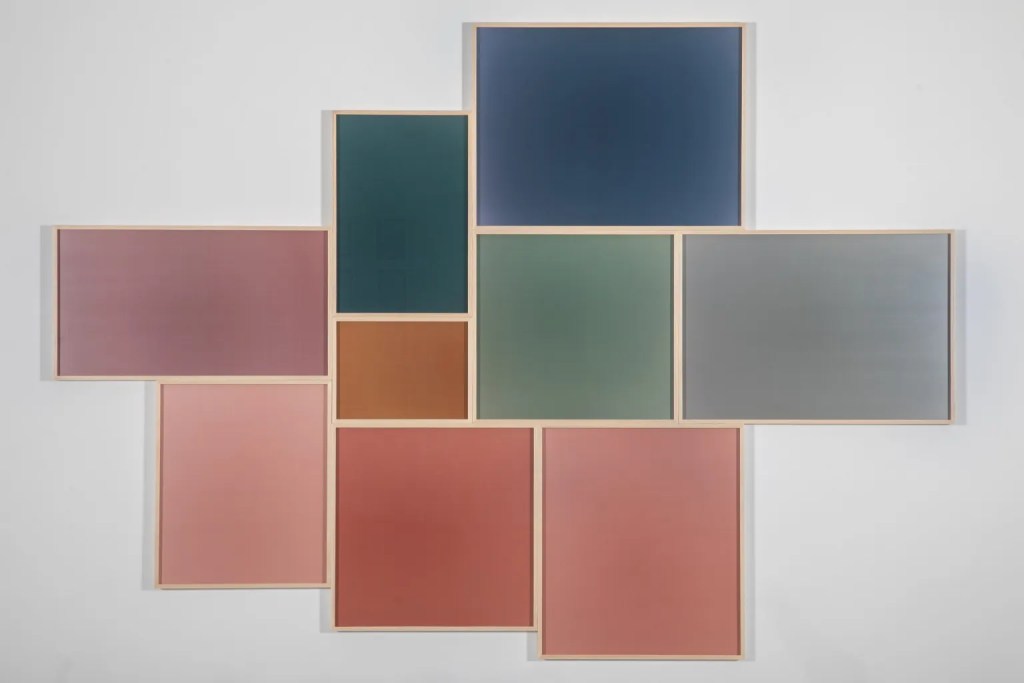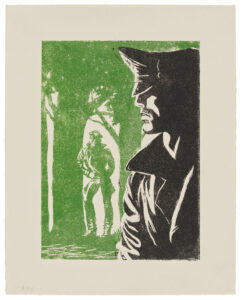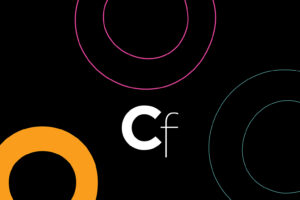Exhibition at Children’s Museum Decolonizes Color


What is color? The answer to that question is often that it’s subjective. But such vagueness can somehow still leave intact pale, male, and stale color theories of the past as the default. A gem of a group show, All That Remains at the Sugar Hill Children’s Museum of Art and Storytelling, spotlights artists who subvert modernist orthodoxies and open up new vistas in how we might relate to color.
The color blue is centered in some of the works on view by Amanda Martínez, Yiyo Tirado, and Liz Deschenes. It is neither the melancholy hue of Picasso’s blue period nor that ethereal color of the Italian Renaissance. But that’s precisely what makes each of their works so captivating — they push blue into other conceptual territories.
Martínez explores Indigenous approaches to rendering water in her sculpture “Working Meditation 1. (Rio Grande)” (2023). In the Rio Grande-area weaving tradition, artists interweave variegated horizontal stripes to evoke rivers. Layering light blue blocks and stripes to form a fluctuating pattern of waves and ripples, the artist invites viewers into an Indigenous connection to land that she calls “querencia.”

Whatever sacred meanings blue holds, corporate giants like Microsoft, Chase Bank, American Express, Dell, HP, IBM, and Visa have flattened it into a soulless graphic marker of brand identity. Tirado reclaims these hues in his monochromatic blue LED screens modeled on the advertising screens in real estate offices (“Real Estate,” 2025). In North America, Puerto Rico, and the Caribbean, unceded Indigenous land and the sky above it in the form of air rights is now a highly speculative commodity. As the greed of corporate real estate investors instigates a widespread affordable housing crisis, these blank blue screens allude to the colonization of all available space as capital.
Deschenes’s dye sublimation print on aluminum, “Indicator #6” (2022), draws out otherwise easily overlooked facets of blue — for instance, the color is shinier because of its metal base, resulting in a subtle iridescence that is hard to see but gives the blue an understated sheen. Deschenes plucked this particular shade from an unexpected, but fitting, source: the color swatches that measure humidity in museum spaces, often located on the back of artworks.

Like Deschenes, Leslie Hewitt and Lucia Koch use photographic processes to capture colors in ways that painting cannot. Koch’s “Polenta” (2025) takes us inside of a cardboard box in which a cut-out “window” looks out onto some foliage. Sunlight filters in, bringing soft warmth and light to some areas of the composition while leaving others in the shadows, creating a sense of dynamism.
In Hewitt’s “Subfield (Extension) (Tension)” (2024), a geometric arrangement of monochromatic chromogenic prints probes how color is relational: The brown and rose tones in the work will appear different to the eye when they are adjacent to the green and gray expanses of color than if they were only surrounded by the gallery’s white walls.

Whereas most artists in this show adhere to a monochromatic or limited palette, colors dance with pizazz in Kevin Umaña’s mixed media works. His geometric compositions honor the aesthetics of the Indigenous Pipil people in El Salvador who endured a devastating genocide in the 1930s at the hands of dictator Maximiliano Hernández Martínez. Umaña refers to his works as visual puzzles. Conceptually, the puzzle evokes the complexity of coming to terms with the genocide’s legacy, while aesthetically it refers to the zigzagging forms in traditional Pipil art that signify rivers and snakes, as well as its kaleidoscopic colors.
This exhibition probes Indigenous, non-White ways of seeing color, as well as how photographic techniques can achieve colors that painting can’t. While it’s easy to claim that everything has been done before, this exhibition is proof that unexplored vistas for color await those willing to travel off the beaten path.



All That Remains continues at the Sugar Hill Museum of Art & Storytelling (898 St. Nicholas Avenue, Sugar Hill, Manhattan) through May 25. The exhibition was curated by C.J. Chueca and Omar López-Chahoud.




